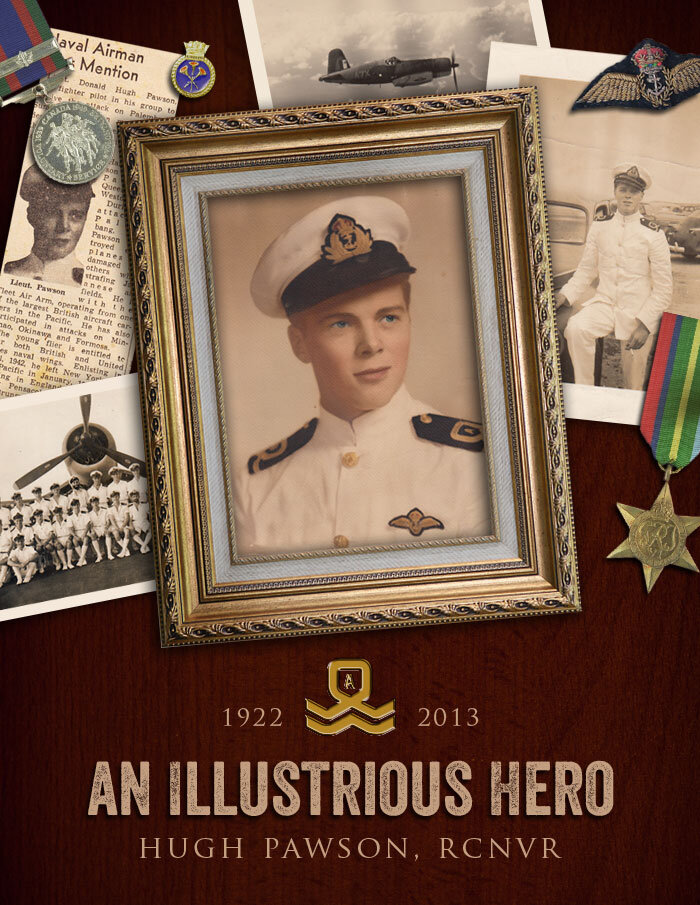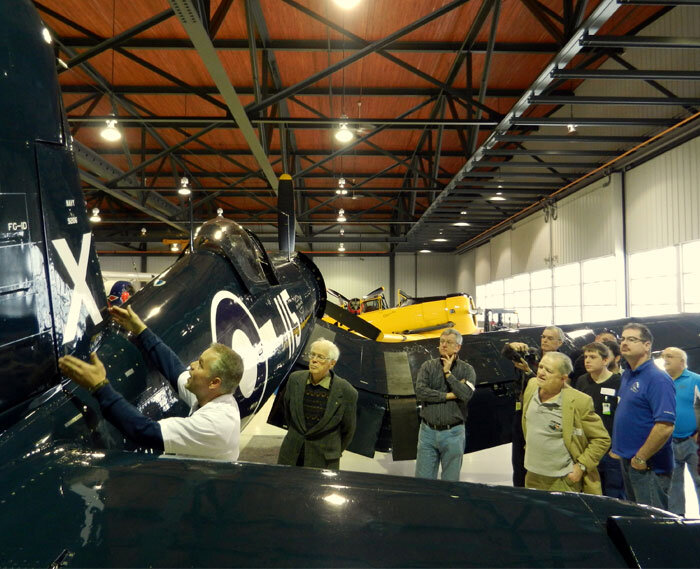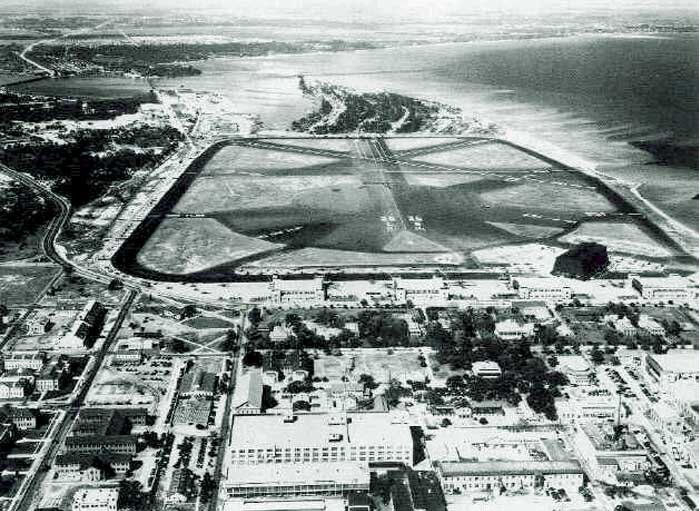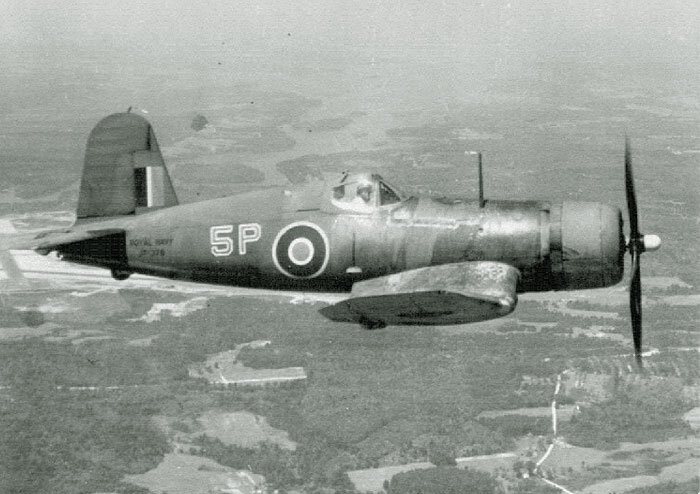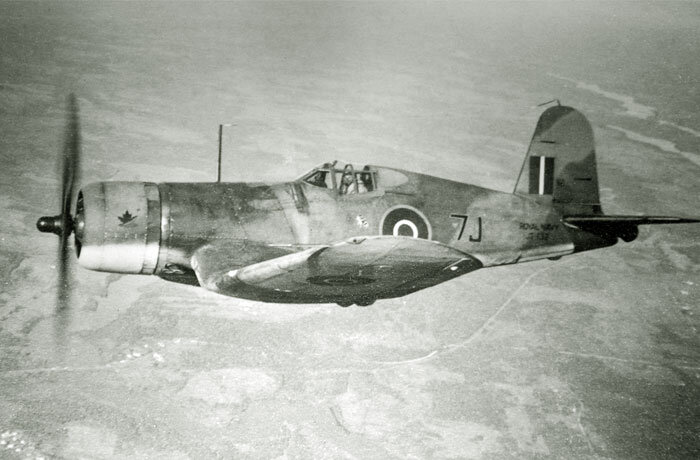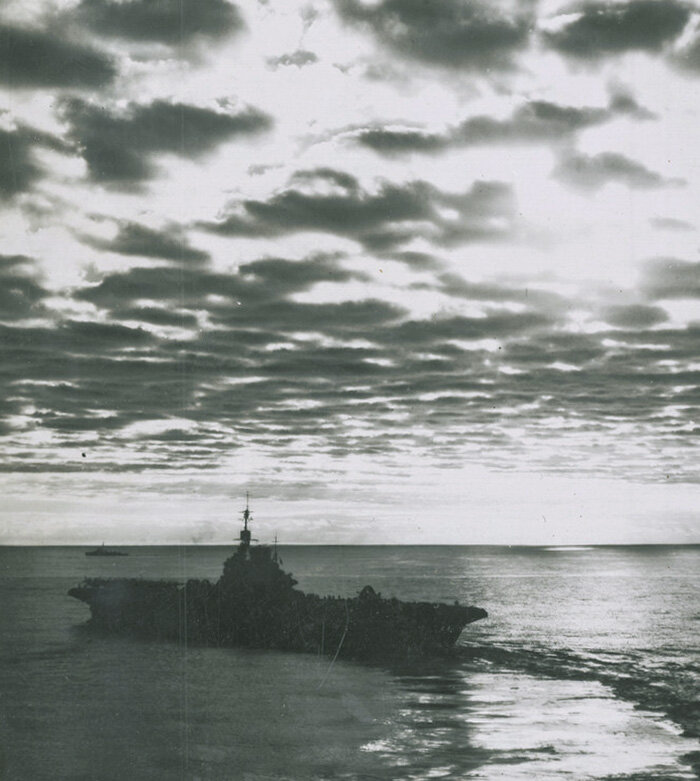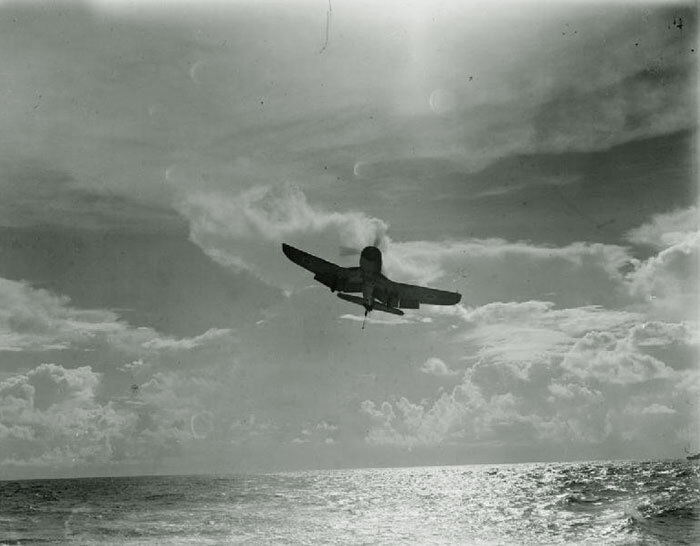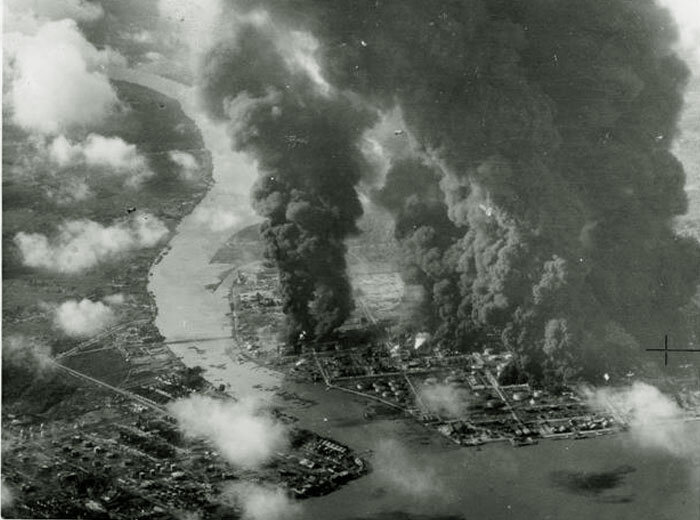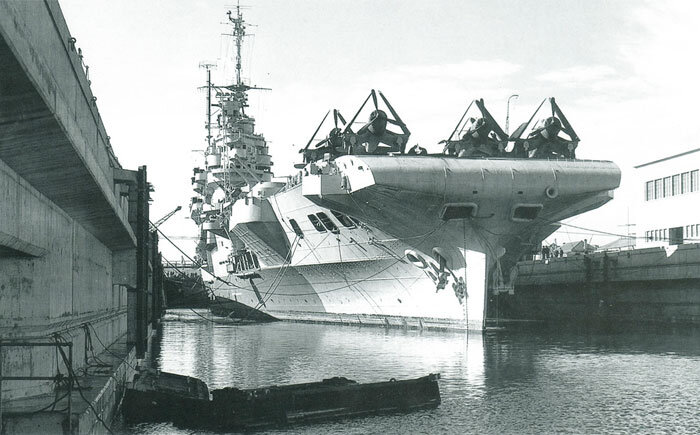AN ILLUSTRIOUS HERO — The Hugh Pawson story
If you were to ask devotees of Second World War aviation history what the words Furious, Glorious, Indomitable, Courageous, Indefatigable, Formidable, Audacious, Illustrious, Implacable, Magnificent and finally Victorious meant to them, they would no doubt tell you that these were the names of some of the mightiest and most storied aircraft carriers of the Royal Navy during the Second World War, operating aircraft of the Fleet Air Arm. They, of course, would be correct in saying this, but they would be missing the fact that all of these adjectives also describe in broad terms the character of the men who flew fighter and attack aircraft from the pitching decks of these very same Royal Navy carriers – young men, barely out of their teens, who dropped what they were doing in their hometowns and rural farms and took up arms to fight back abject tyranny on both sides of the globe. All of these adjectives can be prefixed to the names of men like Don Sheppard, Robert Gray, Bill Atkinson, Dickie Cork, Roy Baker-Falkner and Eugene Esmonde. They also accurately describe some aspects of the now-silenced spirit of Royal Canadian Naval Volunteer Reserve Lieutenant Donald Hugh “Moe” Pawson, a Fleet Air Arm Corsair pilot who was also one of us at Vintage Wings of Canada. To describe all of Hugh's strengths using the names of Royal Navy aircraft carriers would mean that there was an HMS Humble, HMS Soft Spoken, HMS Selfless or possibly an HMS Elegant. Of course, the metaphor cannot capture the complete man.
Our much-loved Hugh passed away on 28 January 2013 in his 90th year. Just one week before, Hugh came up from Mississauga, Ontario to attend our Vintage Wings of Canada Corsair Ground School and share his operational experiences with the Corsair pilots, members of Vintage Wings of Canada and Corsair aficionados. Sharp of mind and strong in character still, he climbed one last time up the towering side of his much-loved Corsair and sat down in the cockpit he knew all too well from a successful career as a Fleet Air Arm fighter pilot.
Hugh Pawson's passing gave us all a shock, for the last time we saw him, he was as strong and as bold and as happy as one could expect from a man entering his tenth decade on this planet. He was tall and elegant, quiet yet communicative. He was still adventurous – willing to travel three hundred miles to see us, willing to climb back into that old Chance Vought saddle again. Hugh shared stories without self-promoting. He told us of the difficulties and the risks, the joys and the camaraderie of life amongst naval aviators. One could see that the fates of Hugh's friends, the ones lost on operations or who met their deaths as POWs of the Japanese, weighed heavily on his heart, even seventy years after the war. He told his story not to place himself or anyone else upon a pedestal, but to demonstrate to the spirits of his missing comrades that they were not forgotten. He gave us the detail and the colour of existence on Illustrious – the smells, the sights, the sounds – the very fabric of it, not for adulation, but that it would be known by someone else and not forgotten. Hugh understood that most of his brethren were now gone, that many had failed to tell their stories and that without these stories the truth cannot be known. The true story must be captured and held in respect, nurtured, and shared. Hugh helped us with that mission.
Hugh, we will not let you down. Your input, your stories, your encouragement has fuelled us for many years to come. It is because of men like you that we now understand who we are and why we do what we do. We maintain airplanes, but we are not maintainers – we are knowledge keepers. We fly airplanes, but we are not pilots – we are role models. We record history, but we are not historians – we are storytellers. We acquire airplanes, but we are not warbird collectors – we are heritage re-patriaters. We fly living, breathing, vintage flying machines, but we are not warbird operators – we are stewards of a visual and functioning legacy of excellence and courage. We spend every waking moment at this purpose. Wherever our Corsair goes, she will carry a full load of fuel and your memory will be stowed in every available space, nook and cranny of that magnificent beast. You have passed the torch to men like Paul Kissmann, Rob Fleck, Francis Bélanger, Mike Potter and Pierre Lapprand. It is in good hands.
Just a week before his death, on 19 January 2013, Hugh Pawson and Paul Kissmann deliver a close-up inspection of the aircraft they both know so well at the Warbird U Corsair Ground School. Photo: Pierre Lapprand
I asked Paul Kissmann, a Corsair pilot and our Chief Pilot, and Pierre Lapprand, historian, photographer and key Vintage Wings volunteer to put Hugh's legacy into a personal reflection. Here is what they said about Hugh:
Paul Kissmann writes: "When I think of Hugh, it is with a smile on my face. He was another of our understated veterans – one who, with great courage, sense of adventure, and love for his country, took up the call to arms as a fighter pilot in the Second World War – and you wouldn't think that upon meeting him. He was such an "awe shucks" kind of gentleman. His stories of flying in the Pacific theatre, getting his first Corsair carrier landing on "blue water operations" in – theatre because there was no time before that – with the entire flight deck looking on he was launched solo – and had only one dry option – figure out how to land back on ship – what courage!! His airfield attacks in Palembang in support of efforts to cripple the oil refineries in the area are stories of legend – strafing down so low, (with very little time, currency or recency on the aircraft) – that they had to pull up to go over anything – it seems you had to be crazy to fly as HIGH as 200 ft on those attacks – you were much more sane if flying below 100 ft – this took courage. He witnessed three of his leads getting shot down, as a wingman, two died in the subsequent crashes and one as a POW of the Japanese. He could still not speak easily of it when we last saw him during our Corsair Ground School. There is no doubt he came back a different man than the kid who went to war on behalf of his country. We were so fortunate that he made time to bring to life the stories of our Corsair. I am privileged to have flown it on his behalf, and that of our other distinguished Fleet Air Arm Corsair pilots like Don Sheppard and Robert Hampton Gray. Hugh is missed already, but not in our hearts and heads – he will find a place there always."
Pierre Lapprand writes: "The recent years in personal contact with Hugh represent so much for me – not only for us being together and sharing aviation events, but also for the gift of being able to stay in constant contact with him. Hugh was thoroughly modern, despite his age, comfortable with the internet and connecting via email. He remained intellectually active to the very end. An astronomy buff and interested in modern aviation, he was a brilliant man with a quick wit, a great sense of repartee, all tinged with good humour. This created interesting conversations that regularly provoked laughter and smiles. He made and maintained many friends at air shows. He was the kind of man people liked to be around. He often told me how Vintage Wings was a great organization, with its collection of aircraft and its great crew of volunteers. He always felt warmly welcomed when visiting us and told me more than once that Mike Potter should be honoured with the Order of Canada. Warm and powerful memories will remain in my heart for all my days. It was, and is still today, an incredible opportunity to get to know Hugh and call him my friend. He was a very humble man, a very nice man, a great man. Farewell Hugh, my friend. I miss you terribly."
The Career of Royal Canadian Naval Volunteer Reserve Lieutenant Donald Hugh “Moe” Pawson – in photos.
Of his early training days, Hugh Pawson explained to his children, in writing, how he got to become a Royal Navy fighter pilot, and his explanation confirms our research: “I entered the University of Toronto in the fall of '40. However, the war had started, so I applied for enlistment in the Royal Navy Fleet Air Arm. I failed my first RCAF medical due to what the doc called a lazy muscle in my eye. He told me to take some eye exercises he prescribed and see him again in a few months, which I did and passed. After what seemed a long wait to a young aspiring pilot, I took a train to Dartmouth and sailed for the UK in the spring of 1942, when German U boats were having a field day in the North Atlantic.
After more waiting in the UK, I finally went before a board of RN captains who asked a lot of questions and finally accepted me as candidate for flying school. Then came ground school training at Gosport, near Portsmouth and a short stint in the North Sea on a target ship for torpedo pilots in training. Since all airfields in the UK were operational, flying training for the FAA was here at Kingston (at No. 31 Service Flying Training School) or in the USA. I was lucky to join the group training with the US Navy at Grosse Ile, Michigan and Pensacola in Florida. What a wonderful place to train! After getting my US Navy wings, we took operational training at Miami for 2-3 months before moving to Maine in New England to train on Wildcats and Corsairs prior to forming a Corsair squadron.”
A photograph taken during Pawson's early training days with the caption indicating it as taken at HMS St. Vincent in August of 1942. This photo must have been taken when these young men (Pawson on left and Fred Moore on the right) had just been issued new gear, for their flight boots, suits and gauntlets are in brand new condition. After crossing the Atlantic in 1942, Hugh had orders to join Pilots Training Course No. 39 at St. Vincent. Many young pilots-to-be couldn't wait to send home photographs of themselves in the heroic-looking gear of an airman. Although similar, this photo was taken at a different time than the following image as there are several differences to be noted – different bricks on the building in the background, goggles, and no Gosport speaking tube. Speaking of Gosport (pun intended) this photograph was taken at HMS St. Vincent which was a Fleet Air Arm shore establishment in Gosport, Hampshire, England at which pilots and observers of the Fleet Air Arm spent their first few weeks. St. Vincent was a training facility for officers of the Fleet Air Arm and an overflow for the Royal Navy barracks. A signal school was also established along with a torpedo training section. Photo via Pawson Family Archive
Related Stories
Click on image
The caption with this photograph simply says “October, 1942”, and it was clearly taken during Pawson's early training days on Pilot Course No. 39, as he is wearing the flight gear associated with RAF and RCAF flight training in cooler weather, including a gosport tube communications system. Given the gear he was wearing in the previous image taken at St. Vincent, and the fact that other Canadian Naval pilots (such as Hellcat pilot Lt. Bill Atkinson, DSC) did their basic flying training there, this is also likely St. Vincent or the airfield they trained at nearby. After his basic pilot training in England, Hugh was sent back across the Atlantic to US Naval Air Station Grosse Ile, Michigan for Flight Training and then on to USNAS Pensacola, Florida for further flight training. Photo via Pawson Family Archive
This postwar photograph of a parade at HMS St. Vincent helps us confirm that the previous photograph (two before this one) was taken at the same place. The arcade of arches and brick columns is identical to those visible in the opening photograph with Pawson and Moore. This is the very same facility that another famous Canadian RCNVR Corsair pilot, Lieutenant Robert Hampton Gray, VC, began his flying career. Like Gray, Pawson would return to North America to complete his flying training (Gray at Kingston, Ontario and Pawson at Pensacola and Grosse Ile, U.S.A.)
In August of 1942, Hugh Pawson (left rear) appears to be in England, as this photo's caption states that it was taken on Isle of Thanet at sea. Isle of Thanet, or properly TSS Isle of Thanet, was an English Channel ferry, famous for its participation in the Dunkirk evacuation. The six men are “square-rigged” and wearing Cadet Rating white bands around their hats. Square rig, which consisted of jumper, bell bottom trousers and round hat, was worn by all seaman ratings and those who passed the Admiralty Selection Board were issued with two white cap bands to be worn in place of the normal cap badges and these denoted them as ‘Cadet Ratings.' They were not afforded the title ‘officers under training’ until the final two weeks of the 12-week course. Back row: Hugh "Moe" Pawson, John "Lofty" Thomlison, Clive Woodward, NZ; Front row: Tommy Dunn, Pete Coltman, Podge Morton. Photo via Pawson Family Archive
Isle of Thanet as a Dover and English Channel ferry. In August of 1940, Isle of Thanet was fitted up at Merseyside as a Fleet Air Arm target vessel and then commissioned as HMS Isle of Thanet. From refit, she went to work at Crail Naval Air Station in Scotland as a target ship for the Naval Air Torpedo School. Hugh and his friends were there to do a short stint as hands aboard the vessel. Photo via Roy Thornton Collection
The caption in Hugh's photo album reads “The "Natives" at McAdam, N.B., Oct 42”. McAdam Junction was an important railway hub and service centre during the Second World War. Perhaps the young sailors got off the train from Halifax to pose for this shot during a long wait before moving on to their final destinations which, in the case of Hugh Pawson,was Grosse Ile, Michigan and Pensacola, Florida. If the caption says October '42 and the photo of them aboard Isle of Thanet says August '42, then this shot was taken upon their return. Hugh is at the centre back with two sailors on his shoulders. Photo via Pawson Family Archive
Naval Air Station Grosse Ile was an airfield located on the southern tip of Grosse Ile, Michigan. It operated from 1927 until late 1969, and is now a township airport. During the Second World War, NASGI was one of the largest primary flight training stations for Naval aviators and other Allied pilots. Among the many thousands of Navy pilots who began their careers at NASGI were former President George H.W. Bush, and game show host Bob Barker. During the war, over 5,000 pilots received training at Grosse Ile, mostly Navy cadets, along with over a thousand RAF pilot trainees. The primary aircraft stationed at Naval Air Station Grosse Ile during the war years were Consolidated PBY Catalinas, Vought F4U Corsairs, Curtiss SB2C Helldivers, and Grumman TBM Avengers. Training was also conducted using SNJ, and Boeing Stearman trainers. Image via Wikipedia
The massive US Naval Air Station Pensacola located on the coast of the Florida panhandle. It was here in sunny Florida that Hugh did further training on SNJs (Texan/Harvard.)
Four United States Navy SNJ trainers in surprising numerical order (45, 46, 47, 48) thunder across Pensacola's famous multiple runway configuration. Hugh would gain additional flight time on these types of aircraft before heading back north to Lewiston and Brunswick. Maine for Corsair conversion.
Three Pensacola-based SNJ Trainers form up echelon left over the Gulf of Mexico. Hugh would fly the SNJ and earn his Navy wings at Pensacola. Having trained at a USN base, Hugh was also entitled to wear the US Navy's wings of gold as well as his Royal Navy FAA wings.
Officer Donald Hugh “Moe” Pawson cuts a handsome and dashing figure in his crisp Royal Navy whites. He wears the bullion “Wavy Navy” epaulette stripes and loop of a Sub-Lieutenant of the Royal Canadian Naval Volunteer Reserve (Air Branch). In the middle of the square loop of shoulder braid is the letter “A” for Air Branch. Given the fact that Hugh has no naval aviator wings and that the cars behind are American, we might presume that this image was taken at Grosse Ile or more likely later at Pensacola, before or possibly on the day he received his wings. Hugh is smoking a cigarette, something he no doubt later gave up, given his eventual longevity. Photo: Pawson Family Archive
A freshly minted aviator of the Royal Canadian Naval Volunteer Reserve. This hand tinted photograph shows us a hint of the youth and internal strength that would be needed for Hugh to survive the coming hardships. Photo via Pawson Family Archive
From advanced flying training and his Navy wings at Pensacola, Hugh was sent to the neighbouring airfields at Lewiston and Brunswick, Maine – essentially a combined Corsair OTU, where he met three other Corsair pilots who were training up to fly with 1830 Squadron, now aboard HMS Illustrious. Though they had their wings, the young, inexperienced pilots would soon learn that it was a big step from SNJs to Grumman Martlets (Wildcats) and to the high performance Chance Vought Corsair. Here, a little heavy footwork on the brakes by another Fleet Air Arm pilot trainee resulted in a nose-over at Brunswick's Royal Navy training facility. Photo via Howard King
A great shot of a Royal Navy F4U-1A in flight out of Brunswick, Maine. This might have been one of the Corsairs Hugh flew during his time there. When researching this story, I found a website called “Corsair Country” with photographs submitted by Howard King, the son of another Royal Navy Corsair pilot from Brunswick. For an interesting video of a model that shows what the Brunswick Corsairs and in particular this Corsair (5P) looked like, click here. It is Howard King's father, Royal Navy Sub-Lieutenant Peter King, who is flying the Corsair in this photograph. Photo via Howard King
Low-level flying training at Brunswick, Maine introduced some interesting new twists. This F4U likely crash-landed on the ice of Sebago Lake, Maine and ran up on to the rocky shore (there is no evidence that it crashed in the direction it is pointed) . Photo via Howard King at Corsair Country
Located on the Androscoggin River, one mile east of Brunswick, Maine and 26 miles northeast of Portland, Naval Air Station Brunswick served mainly as an advanced flight training facility for Royal Canadian Air Force and Royal Navy Fleet Air Arm squadrons that were transitioning to the Chance Vought F4U Corsair fighter. However, the base also supported operational detachments of various U.S. Navy squadrons. In this shot we can see Corsairs, Wildcats, Avengers and SNJ/Texans.
A photograph of one of Brunswick's Corsair-crammed hangars. When the first four FAA Corsair squadrons, two of which 1830 and 1833, were deployed on Illustrious for that first cruise, they did not have time to actually qualify for landing Corsairs on a carrier at Brunswick, but had to do that in the UK. The Squadrons did sail with their aircraft to the UK from Virginia Beach aboard the carrier HMS Trumpeter... but get this, the pilots couldn't "land on" aboard Trumpeter, as they weren't qualified. Instead they landed at what is probably now NAS Oceana, and literally taxied their Corsairs themselves down the city streets, with engines running and their wings folded, before the Corsairs were hoisted aboard Trumpeter!
An early model Corsair, based at Brunswick, Maine slides in close to the camera to reveal her curious Canadian style Maple Leaf nose art. Naval Air Station Brunswick, Maine, was originally constructed and occupied in March 1943, and was first commissioned on 15 April 1943, to train and form up Royal Navy Fleet Air Arm pilots to fly squadrons of the Chance Vought F4U Corsair, and of the Grumman TBF Avenger and F6F Hellcat, for the British Naval Command. Hugh, along with three other Canadians, was training up on the Corsair here in 1943 and was part of a squadron forming up to go to Ceylon to replace pilots lost in accidents and in action with HMS Illustrious. Research indicates that 1830 Squadron, with which Pawson was to serve aboard Illustrious, was formed up in June of 1943, but at NAS Quonset Point, North Kingstown, Rhode Island. In January of 1944, Hugh was ready for operations and was sent via train to San Francisco, California to embark on a ship for Ceylon.
A formation of six Chance Vought Corsairs flying over New England countryside, with British markings and Royal Navy FAA airmen at the controls. This was towards the conclusion of their training in America, just before their departure for deck landing trials. They were flying from Lewiston, Maine. Photo: Imperial War Museum
Five Chance Vought Corsairs from the same group as the previous photo fly in tight formation over the New England countryside, with Royal Navy markings and airmen at the controls. Photo: Imperial War Museum
Data plate for F4U-1 Corsair JT289 which was lost in a fatal accident on 1 December 1943 with SLt J.D. Wallace of 1836 Squadron at the controls. The aircraft broke up in flight during a dive from 25,000 feet over the city of Brunswick, Maine. The engine landed in the garden of the home owned at one time by Harriet Beacher Stowe (the American abolitionist and author of Uncle Tom's Cabin). The Corsair would almost certainly have been around when Hugh Pawson served at Brunswick, and he may very well have flown her. Photo by Richard Mallory Allnutt
Lord Halifax, British ambassador to Washington, inspects fresh graduates from the Brunswick Corsair OTU at about the time, in 1944, when Hugh passed through. Edward Frederick Lindley Wood, 1st Earl of Halifax, KG, OM, GCSI, GCMG, GCIE, TD, PC (16 April 1881 – 23 December 1959), known as The Lord Irwin from 1925 until 1934 and as The Viscount Halifax from 1934 until 1944, was one of the most senior British Conservative politicians of the 1930s, during which he held several senior ministerial posts, most notably as Foreign Secretary from 1938 to 1940. As such he is often regarded as one of the architects of the policy of appeasement prior to World War II. During the war, he was shuffled out of Parliament and served as British Ambassador in Washington.
And now, on to 1830 Squadron, Fleet Air Arm and HMS Illustrious:
The following images will give you a glimpse of the aircraft carrier that would be Hugh's home for a year and the fighter training and operations aboard her. Illustrious was not the first ship of the Royal Navy to hold that name. There were four ships named Illustrious before her and one after her (also a carrier.)
Illustrious was built by Vickers-Armstrongs at Barrow-in-Furness, Cumbria, on the west coast of England, at a cost of £3,800,000. She was launched in 1939 and commissioned on 16 April 1940. She displaced 28,000 tons and carried up to 57 aircraft, including about 33 to 36 in her armoured hangar (depending on type.) She was nicknamed "Lusty" by the men who served in her.
Her first service station was in the Mediterranean Sea, protecting convoys and operating against the enemy in North Africa. On 11 November 1940 she became the first carrier in history to launch a major strike against an enemy fleet in a daring attack against the Italian fleet at Taranto. Twenty-one aircraft from Numbers 813, 815, 819, and 824 Squadrons based on Illustrious attacked the Italian fleet at night. The Italians were caught off guard, and one battleship was sunk and two were heavily damaged. The success of this attack was the inspiration for the Japanese attack on Pearl Harbor a year later.
Illustrious had two Corsair fighter squadrons on board during her deployment with the Royal Navy's Eastern Fleet and British Pacific Fleet – 1830 and 1833 Squadrons. Hugh's 1830 Squadron formed at Quonset Point, Rhode Island as a fighter squadron with 10 Corsair I aircraft in June 1943. In October 1943 the squadron embarked with 10 Corsair IIs on HMS Slinger for passage to Belfast and subsequently moved to Stretton. In December 1943 the squadron embarked on HMS Illustrious as part of the 15th Naval Fighter Wing, sailing in January 1944 to Ceylon for the Eastern Fleet. At the same time, Hugh Pawson was making his way round the world the other way to hook up with Illustrious in Ceylon.
The launch of HMS Illustrious on 5 April 1939 at Vickers-Armstrongs Works in Barrow-in-Furness. Photo via Richard Mallory Allnutt collection
HMS Illustrious as seen at sunset in the Atlantic Ocean from the flight deck of HMS Unicorn. Corsairs and Barracudas can be seen in silhouette aboard her flight deck. Januar, 1944. (William Johnson photo – via Richard Mallory Allnutt collection)
Many Fleet Air Arm fighter units were created and equipped in the U.S., at Quonset Point, Rhode Island, Brunswick, Maine, and many other places. They were then shipped to war theatres on board escort carriers. The first Corsair unit of the FAA was No. 1830 Squadron, created on the first of June 1943, and soon operating from HMS Illustrious. This is a photo of an Illustrious-based Corsair taxiing after landing in 1943, shortly after the squadron formed up at Quonset Point. Photo: Imperial War Museum A 20999, Lt. C.H. Parnell, RN FAA
This image of a FAA Corsair dropping down to catch perhaps the second or third of seven wires was in Hugh's album, but has been identified as having been taken the year before he joined the ship's complement. Photo via Pawson Family Album
All landings on Fleet Air Arm carriers were dangerous and all were attempted by only qualified and highly trained pilots. Still, many aircraft and pilots were lost to accidents as a result of trying to land one of the Navy's most challenging aircraft on a short and narrow steel island that was moving away from you. Here, rescue crews and fire crews in asbestos suits attempt to extract the pilot from this overturned Corsair on the deck of Illustrious in 1943. It is worthy of note that Hugh Pawson made his very first carrier deck landing, or “trap”, at sea during blue water operations and landed the difficult aircraft just fine. Photo: Imperial War Museum A 20999, Lt. C.H. Parnell, RN FAA
A gorgeous sunny day and an HMS Illustrious Corsair is down and dirty with flaps, hook and gear hanging. What could go wrong? Photo: Imperial War Museum A 24275, Lt. C. Trusler, RN FAA
Much of the danger of naval aviation lay not in the operations against enemy targets and adversaries, but rather in simply launching from and recovering aboard Royal Navy Fleet Carriers like HMS Illustrious. The photograph found in Hugh's collection predates him joining the complement on board the carrier. Taken on 12 September 1943, this shot shows a Corsair that has come to grief against the carrier's island while the ship was operating near Greenock, Scotland. Photo via Pawson Family Archive
Corsairs and Barracudas aboard the flight deck of HMS Unicorn as she sails for Trincomalee in January 1944 with HMS Illustrious and battleship HMS Queen Elizabeth to her rear. The nearest Fairey Barracuda on the far left, P9886, went on to serve aboard HMS Illustrious, being lost in a non-fatal takeoff accident on 11 June 1944 with SLt D.B. Hayter at the controls. William Johnson photo – via Richard Mallory Allnutt collection
HMS Illustrious just off Gibraltar in January 1944, as seen from the flight deck of HMS Unicorn. Her deck is arrayed with Corsairs and Barracudas for the journey to the Eastern Fleet in the Indian Ocean at Trincomalee, Ceylon. While Illustrious was making this journey, Hugh Pawson was boarding a ship in San Francisco, bound for Ceylon as well. They would soon meet up. The eight horizontal crane-like structures or masts protruding from her sides are part of the long-range radio antenna. These communications masts run along each side of the ship, and deploy vertically when in use, but are lowered during aircraft operations for obvious reasons. William Johnson photo – via Richard Mallory Allnutt collection
After his OTU training on Corsairs at Brunswick, Maine, Hugh boarded a ship in San Francisco, bound for Ceylon, where he was to train further on the Chance Vought Corsair and to eventually catch up with 1830 Squadron. The FAA OTU 757 Squadron operated at HMS Rajaliya (Sinahala for “Eagle”) at Puttalam on the northwest coast of Ceylon. Puttalam is famous among history buffs as the place that sometimes used elephants instead of wheeled mules to move aircraft around. As the British expanded their operations on the island, the airstrip of HMS Rajaliya was cut out of thick jungle at Puttalam. The grass strip was reinforced with metal. Even the heavy American-built Chance Vought F4U Corsairs used the runway, but during the wet season many a Corsair went sliding off into the muddy ground that surrounded the strip. It was then that the Navy called in its special Pachyderm towing vehicles to haul the aircraft back to solid ground. Operating in conditions where towing tractors became quickly bogged down, the “Puttalam Elephants” provided an invaluable service. They soon became part of the flying and ground crews fraternity.
A photograph of Hugh Pawson standing proudly on a 757 Squadron Corsair at Puttalam, Ceylon in 1944. 757 Squadron Fleet Air Arm was the FAA OTU at Puttalam, training pilots on everything from Supermarine Walruses to the Corsair, Seafire or Martlet. It was at Puttalam that Hugh began the process of becoming a true Royal Navy carrier pilot. He joined the carrier and 1830 Squadron in early May of 1944. While on Ceylon, Hugh also flew Grumman Martlet (Wildcat) fighters, likely with 757. Photo via Pawson Family Archive
Trincomalee Harbour, Ceylon; February 1944. HMS Unicorn is in the foreground, with cruiser HMS Renown and carrier HMS Illustrious immediately behind. Hugh Pawson left New York City in January of 1944, bound for the Far East and set to join 1830 Squadron aboard Illustrious. This photo would have been taken about the time Pawson was reaching Ceylon. One can see the long-range radio masts deployed vertically on Unicorn and Illustrious in the distance. William Johnson photo – via Richard Mallory Allnutt collection
The cruiser HMS Renown and carrier HMS Illustrious in Trincomalee Harbour, Ceylon. They arrived on 31 January 1944 so this is probably in early February 1944, shortly before they departed to join the British Pacific Fleet in March 1944. William Johnson photo – via Richard Mallory Allnutt collection
A Royal Navy Corsair seems to be torque-stalling in an attempt to put max power on for a go around. This could not have ended happily. This photograph was taken on Illustrious after she had made her way to the Southeast Asian theatre of operations, as this doomed Corsair sports the SEAC Roundels – sans red centre circle. Photo: Imperial War Museum A 29271, Lt. C.H. Parnell, RN FAA
Pilots of 15 Fighter Wing, Surabaya, Java, 19 May 1944, with Hugh Pawson standing at extreme right in the back row. This was the day of Hugh Pawson's 22nd birthday and was shortly after he joined the squadron. The 15th Naval Fighter Wing was, just one month before, commanded by Lieutenant Commander Richard “Dickie” Cork, a Royal Navy ace and a rare naval fighter pilot flying Hawker Hurricanes with 242 Canadian Squadron during the Battle of Britain. Sadly, he was killed at China Bay, Trincomalee, Ceylon when he collided with another aircraft, already on the active runway, while making his second attempt to land on the local airfield at night. The man who was sent to take command was Lieutenant Commander (acting) Mike Tritton who went on to gain their respect and form the pilots into a true fighting force. He is seated sixth from the left. 15 Wing was comprised of the squadrons attached to HMS Illustrious. Only in the Navy could you find bearded fighter pilots! Photo via Pawson Family Archive
Another photograph from the same sitting as the previous shot shows 30 pilots of the 15th Fighter Wings of the Royal Navy's Fleet Air Arm at Surabaya. Hugh stands at far right. Mike Tritton, the Wing's new Commander sits dead centre. The pilots in the Wing group photo are as follows: Back row: Harry Whelpton, Reg Shaw, Matt Barbour, Tony Graham-Cann, Jock Fullerton, R. Quigg, Steve Starkey, Pete Richardson (wing observer), Jake Millard, Eric Rogers, Hugh MacLaren, Colin Facer, Stan Buchan, Gord Aitken, Moe Pawson; Middle row, seated: S. Seebeck, Johnny Baker, Alan Booth, Bosh Munnock, Norm Hanson, Mike Tritton, Bud Sutton, Percy Cole, Don Hadman, Tiddles Brown, Les Retallick; Front row, sitting on deck: Neil Brynildsen, Jimmy Clark, Mike Ritchie, Brian Guy. Photo via Pawson Family Archive
A close-up of the previous photo reveals Hugh at right, resplendent in his Navy whites and tropical shorts. Photo via Pawson Family Archive
An image from Hugh Pawson's album shows 16 Fleet Air Arm Corsairs from Illustrious doing a flypast of the waterfront in Colombo, Ceylon (today's Sri Lanka.) The date is Remembrance Day, 11 November 1944, and with the war beginning to wind down and Japan reeling backwards to their homeland, the Royal Navy was clearly taking the time to remember their losses and impress civilian and military personnel watching from the Galle Face Green, the open grassy sward in front of the Ceylonese Houses of Parliament on Colombo. It was also the fourth anniversary of Illustrious' attack on the Italian fleet at Taranto in the Mediterranean Sea, giving these proud FAA aviators plenty of reason to fly the flag. Photo via Pawson Family Archive
Thousands of people cram the open area on the Colombo waterfront known as Galle Face Green. In the distance are the Ceylonese Parliament Buildings. The caption accompanying this photograph states “22 flight coming out final turn on target, Colombo, Nov 11, 1944”, so this is likely all part of the Royal Navy's flying demonstration on Remembrance Day or possibly the 4th anniversary of the Battle of Taranto, in which Illustrious played such a powerful role. We are not sure if 1830 Squadron was part of the flypasts or if Hugh was the photographer on the ground. Photo via Pawson Family Archive
A recent photograph taken from a hotel balcony in Colombo, Sri Lanka shows the same building, now known as the Old Parliament Buildings. Photo by Brian Scott
A final image in the group of photographs from Pawson's album that were taken at Galle Face Green, Colombo on 11 November 1944. It shows possibly the same group of Corsairs (22 Flight?) and is certainly taken at the same time as the cloud formations are very similar. We also see other military equipment on display including a Fairey Barracuda aircraft, which must have been trucked to the site. Photo: Pawson Family Archive
HMS Illustrious formed the core of a rebuilt Eastern Fleet, deployed to the Indian Ocean. Embarked on her were two Corsair squadrons, 1830 and 1833. Following a refit at Durban (South Africa) between July and December 1944, HMS Illustrious returned to the Eastern Fleet from December 1944 to January 1945, when she took part in air strikes against oilfields on Sumatra in December 1944, and Palembang in January 1945. Hugh Pawson was Mentioned in Despatches for his actions against the oil refineries and airfields at Palembang, Sumatra. From January 1945, Illustrious was assigned to the British Pacific Fleet. After repairs in a Sydney, Australia dry dock, operations recommenced in March and again in April 1945, with air strikes against Sakishima Gunto and Formosa.
The burning oil refineries at Palembang, Sumatra. Hugh Pawson joined the carrier HMS Illustrious on 5 May 1944. Illustrious and Pawson's 1830 Squadron steamed for Sumatra after her refit in Durban to take part in Operation Meridian and Meridian II. Planned for two days earlier but delayed because of bad weather, the first Meridian attack took place on 24 January with 43 Avengers, armed with 172 500lb bombs, supported by 12 rocket-firing Fairey Firefly aircraft and about 50 fighters of which Pawson's Corsair was one. Some of the Avengers and part of the fighter escort attacked the Japanese-held principal airfields in the area. The fighter sweep destroyed 34 enemy aircraft on the airfields but could not prevent all the Japanese fighters getting airborne. Pawson was Mentioned in Despatches and gazetted for his service that day, accounting for 8 of the 34 Japanese aircraft destroyed on the ground and two additional damaged.
Despite heavy flak, the operation was a big success. The output of the refinery was halved for three months and most of the oil in the storage tanks was consumed in the fires. During the course of Meridian, a total of seven FAA aircraft were lost. Operation Meridian II followed on 29 January 1945. Photo: Fleet Air Arm Archive
HMS Illustrious sits in dry dock in Australia while her centre propeller shaft is repaired. The Sydney, Australia dry dock or, as it was known, the Captain Cook Graving Dock, was a massive repair facility: 1,139 feet 5 inches (347.29 metres) long, 147 feet 7.5 inches (45 metres) wide and with 45 feet (13.72 metres) draught of water. The dock was not yet finished when Illustrious showed up limping into Sydney harbour. The construction was sufficiently advanced however to allow the emergency docking of HMS Illustrious on 2 March 1945, three weeks before the official opening ceremony. Photo via Pawson Family Archive
Seen here as a fighting unit of the British Pacific Fleet, following her emergency docking in the Captain Cook Graving Dock from 2–5 March to remedy a propeller shaft problem, Illustrious left Sydney in mid-afternoon on 6 March. Some Corsair squadrons, left ashore at the Royal Australian Navy air field at Nowra, flew aboard the next morning, 7 March, off the coast as she headed north for the British Pacific Fleet's advance base at Manus Island, and thence to the assault on Sakishima Gunto – where she suffered kamikaze hits. Photo: Warship Review, courtesy Ashley Moore
Another shot of HMS Illustrious high and dry in Sydney's Captain Cook Graving Dock, with some of her Corsair complement on the forward deck and her long-range communications masts deployed vertically.
A Fleet Air Arm Corsair launches from the deck of HMS Illustrious in the Southeast Asia theatre. We can tell this because the Royal Navy roundel has no centre red circle and carries the bars common to the US Navy.
The hangar deck of HMS Illustrious, absolutely jam-packed with stowed Corsairs and maintenance crews.
Looking like a Ralph Lauren fashion model, and exuding confidence and youthful élan, a handsome Hugh Pawson (centre) poses in civvies with two squadron mates at Diyatalawa, Ceylon, January 1945, while on leave from operations aboard HMS Illustrious. Diyatalawa is a garrison town in the central highlands of Sri Lanka, in the Badulla District of Uva Province. It is at an altitude of 1,499 m (4,918 ft) and, today, has become a popular destination for local holiday makers and leave takers looking for relief from the swelter of coastal Ceylon (Sri Lanka.) Clearly Pawson and his mates were there for the same reason – relief from the swelter of Colombo. Note Pawson's white Grosse Ile sweatshirt. Photo via Pawson Family Archive
HMS Illustrious or possibly Victorious launching Corsairs off Sakishima, in April 1945. The Sakishima Islands (Sakishima Gunto) are an island chain located at the southernmost end of the Japanese Archipelago. At this time, while supporting the invasion of Okinawa, the British Pacific Fleet had sole responsibility for operations in the Sakishima area. Its role was to suppress Japanese air activity, using gunfire and air attack, at potential kamikaze staging airfields that would otherwise be a threat to U.S. Navy vessels operating at Okinawa. The carriers were subject to heavy and repeated kamikaze attacks, but because of their armoured flight decks, the British aircraft carriers proved highly resistant, and returned to action relatively quickly. US Navy ships had decks of wood, which were highly susceptible to damage and gasoline fires. It was here that Illustrious was seriously damaged by a kamikaze attack and had to retire from the fray. Photo via Pawson Family Archive
A Royal Navy secret recce photo (dated 3 January 1945) in Hugh's personal album shows Nobara Airfield, the Imperial Japanese Navy Air Service landing strip on the island of Miyako Jima. The image was taken by a PBY of Air Force United States Pacific Fleet Photographer Interpretations Squadron Two (Interpron Two). While arrows point to barracks buildings we have no difficulty seeing the runways and dispersal revetments. As US Navy and Royal Navy ships and aircraft swept up the Japanese archipelagos like Sakishima on their way to Okinawa, they came up against a deadly surprise – the suicide attacks of the kamikazes. Every airfield on every island up the chain to Japan would offer up sons of the Emperor on the altar of the Divine Wind. Japanese records indicate that seven kamikaze aircraft were launched from Nobara during the Sakishima battles of late March and April of 1945. Photo via Pawson Family Archive
1830 Squadron pilots mill about the deck of HMS Illustrious prior to a launch. Hugh Pawson stands at the right. Left to right: Eric Rogers, Les Retallick, “Tiddles” Brown, Alan Broth, Mike Tritton, Hugh Pawson, Bosh Munnock (cut off in this shot.) Mike Tritton was Lieutenant Commander (acting) AM Tritton, DSC, RNVR who commanded the squadron for all of its operational life aboard Illustrious – from December 1943 to July 1945. Tritton died in 2004 at the age of 83. During his career, he was awarded three Distinguished Service Crosses. Tritton was asked to command 15 Wing (of which 1830 was part) after the loss of their first, and much-loved commander, Dickie Cork. He took command of 15 Naval Fighter Wing in April 1944, and found that his men were much affected by the death of Wing Commander Cork, who had been Douglas Bader's wingman in No. 242 Canadian Squadron during the Battle of Britain. Tritton rebuilt the morale of the squadron's young pilots, earning their admiration and respect, and he led them on a number of successful attacks on Japanese-held shore facilities at Sabang and at Surabaya, during which 15 Wing Corsairs shot down four aircraft. After the war, the much decorated ace managed a brewery for 30 years. Photo via Pawson Family Archive
The crowded flight deck of HMS Illustrious with Fairey Barracudas on the starboard deck and a few Corsairs on the port side. Visible on the foreground deck are the last four of seven arresting wires used to stop Fleet aircraft during recoveries. Photo via Pawson Family Archive
A gorgeous photograph of an 1830 Squadron Corsair overflying China Bay (which actually lies to the left of this photo) near the important northeastern port city of Trincomalee, Ceylon in December of 1944. The spit of land that juts out into the Indian Ocean is the site of Fort Frederick. Prior to the Second World War, the British had built a large airfield to house a permanent RAF base called RAF China Bay along with a fuel storage depot and support facilities for the Royal Navy. The Royal Navy's base there was called HMS Highflyer. After the fall of Singapore to the Japanese, Trincomalee became the home port of the Royal Navy's Eastern Fleet. Photo via Pawson Family Archive
A spectacular shot of HMS Illustrious in the South Pacific steaming at high speed into the sun. Note that both of her aircraft elevators are open to the hangar deck, which means she has no intention of landing on any aircraft, nor are there any on her deck. Photo: Imperial War Museum
A handsome and confident looking Lieutenant Hugh “Moe” Pawson leans against the fuselage of a Fleet Air Arm Corsair in the Pacific theatre, with the Pacific ocean visible beneath the tail of the Corsair. We know that this photograph was taken some time after Hugh was promoted to Lieutenant on 5 December 1944 and before he left the carrier in May of 1945. The large letter “Q” on the tail of the Corsair is known as the deck code. Operating in close proximity with each other, and looking pretty well identical from above, Royal Navy fleet carriers in the British Pacific Fleet carried deck codes – large letters painted on their aft decks to signify the identity of the ship to landing-on pilots. Aircraft operating from a particular carrier would carry that ship's deck code on their tails. The letter “Q” was associated with Illustrious, indicating that this was likely taken on her deck. The Vintage Wings of Canada Lieutenant Robert Hampton Gray Corsair carries the letter “X” denoting it is from Gray's HMS Formidable. Photo via Pawson Family Archive
6 April 1945 – HMS Illustrious narrowly misses taking a direct hit by a Japanese Kamikaze aircraft onto her flight deck. Instead, the dying aircraft struck the water beside the hull and the bomb it was carrying exploded underwater causing serious damage to her hull plates. Hugh Pawson was aboard Illustrious when this explosion happened. On 9 April, Illustrious was detached for a raid against Formosa, but on 14 April she was replaced by her sister, Formidable, and sent to the Philippines for inspection. The damage was more serious than suspected and she returned to Sydney and from there to Rosyth for repairs and refit. By that time, the war was over. Hugh and his pilots were detached from the carrier at Sydney and made their way back to England separately from Illustrious.
There is no date on this photograph, but given the dark blue Naval reefer jacket (sometimes called a Monkey jacket) with campaign ribbons and full RCNVR Lieutenant cuff bands, this could be back in England or even home in Canada. Photo via Pawson Family Archive
Band of Brothers. Hugh Pawson (left) enjoys a beer with fellow Navy pilots at the Mount Hope Ontario Air Show in 1991. One can only imagine the stories and the mutual respect that surrounded this group of aviators – Left to right: Hugh (Corsairs), Murray “Red” Hall (Avengers), John Baker (Corsairs) and the Royal Navy's only Corsair ace, Don Sheppard. Photo via Pawson Family Archive
At the bar for a beer at HMS York, Toronto on 4 May 1991 – Left to right: John Baker, an 1833 Squadron Corsair pilot on HMS Illustrious, Hugh Pawson, also an Illustrious Corsair pilot, Don Sheppard, a Corsair ace with 1836 Squadron aboard HMS Victorious and Don Cooper, an 829 Squadron Fairey Barracuda pilot, also from Victorious. Photo via Pawson family Archive
Close friends. If it were not for Vintage Wings of Canada member and volunteer Pierre Lapprand, we would not have had the pleasure of meeting and knowing Hugh Pawson. The closeness of the two gentle and humble men can easily be seen. In addition, in the eyes of Pierre, we see immense pride to call Hugh his friend.
Hugh Pawson and Vintage Wings of Canada Chief pilot Paul Kissmann meet for the first of many times. Paul, our most experienced Corsair pilot had a lot to learn from the senior Fleet Air Arm pilot. Photo: Pierre Lapprand
Hugh Pawson could always find the Corsair pilots! Here, Corsair pilot and Vintage Wings of Canada founder Mike Potter share a few moments in September 2008. Photo: Pierre Lapprand
Still in love with the old girl after all these years. In September of 2010, Pierre Lapprand and Hugh Pawson travelled to Geneseo, New York to check out the warbird action. Photo: Pierre Lapprand
Hugh Pawson sits in the front row of a large gathering of Corsair pilots and enthusiasts at the first ever Warbird U Corsair Ground School on 27 March 2010. From this day forward, though he lived many miles away, Hugh became one of us – a much-revered one of us. Photo: Peter Handley
This is how we will remember Hugh. Just a week before his death, he sits once again in the cockpit of his old love – the Corsair. He is beaming with youthful joy and clear-mindedness. He looks good. He looks strong still. He looks happy. We are proud that we were able to bring alive these great memories of Hugh Pawson's and to show to him how much he was loved for what he and his mates did so long ago, and so far away. Bravo Zulu Moe! Photo: Pierre Lapprand


